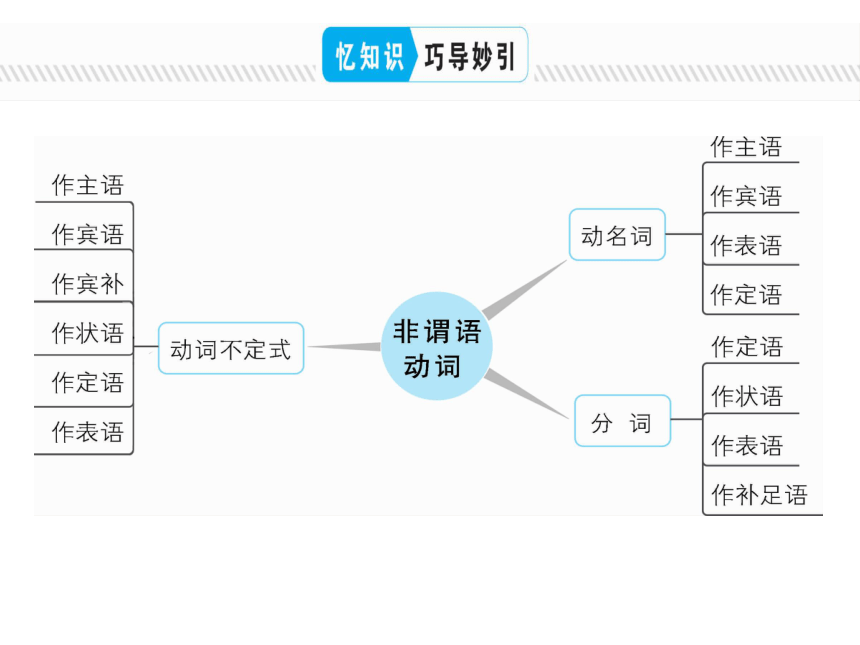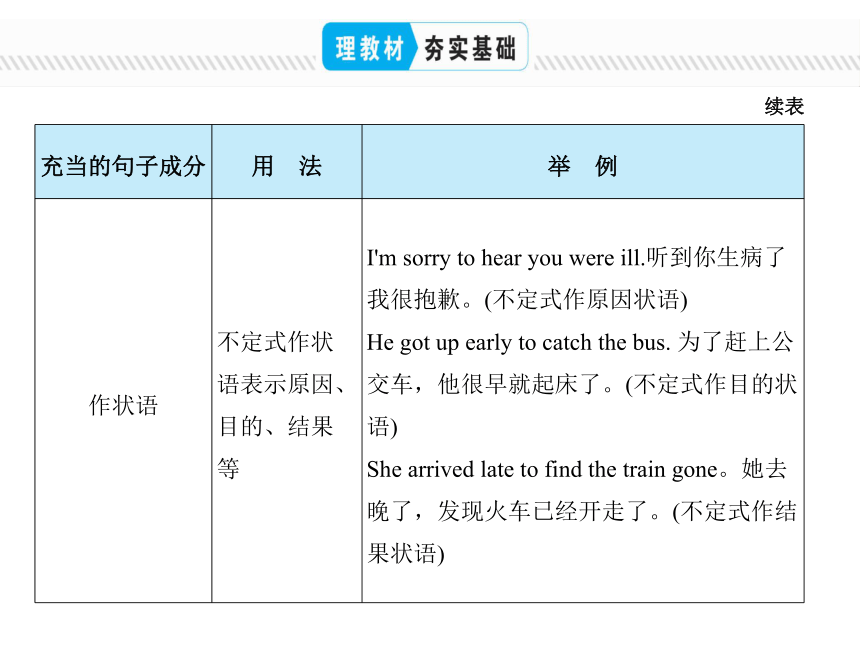中考英语全国通用版二轮专项复习 非谓语动词课件(共33张PPT)
文档属性
| 名称 | 中考英语全国通用版二轮专项复习 非谓语动词课件(共33张PPT) |

|
|
| 格式 | pptx | ||
| 文件大小 | 863.4KB | ||
| 资源类型 | 教案 | ||
| 版本资源 | 通用版 | ||
| 科目 | 英语 | ||
| 更新时间 | 2023-06-20 16:03:26 | ||
图片预览












文档简介
(共33张PPT)
第 10讲 非 谓 语 动 词
忆知识●巧导妙引
理教材●夯实基础
练好题●夯基提能
非谓语动词是与“谓语动词”相对的,谓语动词是指句子中说明主语的动作或状态的句子成分,一个句子中的主语有且只有一个相对应的谓语动词,所以谓语动词的形式要与主语的人称和数保持一致;而句子中不是谓语动词的其他动词,则是非谓语动词, 它不受主语的人称和数的限制。非谓语动词主要包括动词不定式(to do)、动名词(doing)和分词(doing/done)。在句中不能单独作谓语,但仍然保留动词的某些特征。因此,非谓语动词在句中可作主语、宾语、定语、状语、表语等。
例如:He likes to draw pictures. 他喜欢画画。He是主语,likes是谓语动词,是like的三单形式,和主语He保持一致;而后面的to draw(draw的动词不定式)则是非谓语动词,作like的宾语。
或:He likes drawing pictures. drawing(动名词形式)也是非谓语动词, 同样作like的宾语。
这两句话里的draw不能用动词原形(draw),或三单形式(draws),或过去式(drew),因为这几种动词形式只能用于谓语动词的不同时态,不能用于非谓语动词。过去分词形式(drawn)虽然可以做非谓语动词,但是不可以放在like后面作宾语,所以在这里也不可用。
动词不定式
充当的句子成分 用 法 举 例
作主语 不定式作主语,相当于名词或代词,往往在句首用形式主语it代替,而将不定式后置。it代替不定式作形式主语的常用句型: ①It is +adj./n.+(for/of sb.) +to do sth.②It takes/ took sb. some time+to do sth. To do exercise every day is good for our health.=It is good for our health to do exercise every day. 每天锻炼对我们的身体健康有好处。
It took me two hours to finish my homework.完成家庭作业花了我两个小时。
充当的句子成分 用 法 举 例
作宾语 不定式一般用在及物动词后作宾语。及物动词后跟宾语补足语时常用it作形式宾语,而将不定式后置。常用句型:think/find/feel/consider/make/regard…+it+形容词/名词(宾语补足语)+不定式短语 She wants to go to the university some day. 她想要有一天去上大学。
We found it difficult to cross the river.我们发现过河很难。(it为形式宾语,to cross the river 才是found真正的宾语)
续表
续表
充当的句子成分 用 法 举 例
作宾语补足语 在“动词+宾语+不定式”结构中,不定式作宾语补足语 They asked him to sing a song at the party.
在聚会上他们要他唱一首歌。
She wants her brother to help with her housework.她想要她兄弟帮她做家务。
续表
充当的句子成分 用 法 举 例
作状语 不定式作状语表示原因、目的、结果等 I'm sorry to hear you were ill.听到你生病了我很抱歉。(不定式作原因状语)
He got up early to catch the bus. 为了赶上公交车,他很早就起床了。(不定式作目的状语)
She arrived late to find the train gone。她去晚了,发现火车已经开走了。(不定式作结果状语)
续表
充当的句子成分 用 法 举 例
作定语 动词不定式作定语,放在所修饰的名词或代词后 【注意】不定式与其所修饰的词构成逻辑上的动宾关系,而该不定式为不及物动词时,其后须加上适当的介词,构成及物动词短语。 I have some friends to invite.
我有一些朋友要邀请。
He found a good house to live in.
他发现一幢可以住的好房子。
There is nothing to worry about.
没什么可担心的。
续表
充当的句子成分 用 法 举 例
作表语 表示主语的“职业、职责或性质”等,也可表示未来的可能性或假设 Her job is to clean the hall.
他的职责是打扫大厅。
He seems to know everything about this matter.他似乎对这件事情什么都知道。
续表
充当的句子成分 用 法 举 例
和特殊疑词what, which, when, where, how连用 作动词的宾语,相当于宾语从句 I don't know how to do it.=I don't know how I should do it.我不知道该怎么办。
They didn't know what to do.=They didn't know what they should do.
他们不知道该做些什么。
expect dare offer manage fail try decide arrange prepare
hope agree help need want prefer ask plan promise
wish choose hope refuse afford pretend happen — —
【注意】1. 常接动词不定式作宾语的动词(否定形式在to前面加上not)
如:I hope to travel around the world one day.
我希望有一天能环游世界。
He decided not to go home.
他决定不回家。
2. 常接不定式作宾语补足语的动词(否定形式在to前面加上not)
advise force persuade wish beg ask invite want
allow help teach tell order get encourage would like
如:The doctor advises him to do more exercise every day.
医生建议他每天做更多的锻炼。
The doctor advises him not to drink too much.
医生建议他不要喝太多酒。
3. 接不定式作宾语补足语需省略to的动词:(五看两听三使一感觉)
看(see, watch, notice, observe, look at),听(hear, listen to),使得(let, make, have),感觉(feel)。
其中感官类的三类词:看(see, watch, notice, observe, look at), 听(hear, listen to),感觉(feel) 后面接省略to的不定式作宾补时,一般表示不定式表示的这个动作已经完成或者经常发生;而这些动词后面若接现在分词doing作宾补,则表示现在分词doing表示的这个动作正在进行。
如:I saw him go out of the building.
我看到他走出了那栋大楼。
I often see him play football on the playground.
我经常看见他在操场上踢球。
I saw him playing football when I passed the playground.
当我经过操场的时候我看见他正在踢足球。
动词不定式常见句型
too…to…表示“太……而不能……”
如:You are too young to look after yourself.
2. enough to…表示“足够……”。
如:The little girl is not old enough to go to school by herself.
3. Why don't you+do?=Why not+do?表示“为什么不……”。
如:Why don't you ask your teacher for help?=Why not ask your
teacher for help
4. had better+(not) do 表示“最好(不)做……”。
如:You had better not smoke here.
5. Would you please+do?表示“你能做……吗?”。
如:Would you please open the door for me
6. prefer to do sth. rather than do sth. 表示“宁愿做某事而不愿做某事”。
如:Many people prefer to stay at home rather than go on a trip on national
holidays.
7. It's+adj.+(for / of sb.)+to do 表示“对某人来说做某事是……”。
如:It is kind of you to help me./ It is necessary to arrive on time if you have
an appointment.
8. find it+adj.+to do 表示“发现做某事是……”。
如:Tom find it easy to make friends at school.
9. would rather do than do 表示“宁愿做某事而不愿做某事”。
如:We would rather walk home than take a bus during the evening rush hour.
10. It's time to do sth. 表示“该是做某事的时间了”。
如:It's time to eat breakfast.
续表
动名词
动名词由“动词原形+ing”构成,相当于名词、形容词,可以作主语、宾语、表语和定语。
用 法 举 例
作主语 Reading aloud is very important in learning English.
学习英语大声朗读很重要。
Seeing is believing. 眼见为实。
用 法 举 例
作宾语 ①动词后:Lily has to practice playing the piano for 2 hours every day.莉莉每天必须练习两个小时的钢琴。
②介词后:Peter learns English by making word cards.
皮特通过制作单词卡片来学习英语。
作表语 His job is looking after the baby pandas.他的工作是照顾幼年熊猫。
作定语 swimming pool(游泳池), reading room(阅览室)
续表
【注意】1. 常接动名词doing作宾语的动词/动词词组
enjoy keep be busy be proud of avoid look forward to
finish mind feel like be used to(习惯于) be worth put off
consider practice give up be interested in can't stop have problems/
trouble/fun…
miss suggest can't help keep/stop…from be afraid of 2. 既可接不定式又可接动名词但意义不同的动词
stop doing 停止做某事 be used to doing 习惯做某事
stop to do 停下去做另一件事 used to do 过去常常做某事
try doing 尝试做某事 forget doing 忘记做过某事(已做)
try to do 努力做某事 forget to do 忘了做某事(未做)
remember doing 记得做过某事(已做) regret doing 后悔做过某事(已做)
remember to do 记得去做某事(未做) regret to do 对要做的事感到遗憾(未做)
mean doing 意味着做某事 mean to do 打算做某事
分词
分词分为现在分词(v. ing)和过去分词(v. ed)两种。现在分词(v. ing)表示主动(语态)和正在进行(时间);过去分词(v. ed)表示被动(语态)和已经完成(时间)。分词可以在句子中作定语,状语,表语和补足语。
用 法 举 例
作定语 ①作定语的分词为单词时,一般放在被修饰词的前面。
如:It is healthy to drink cold boiled water. 喝凉白开水是健康的。
②当分词短语作定语时,一般放在被修饰词之后,功能相当于定语从句。
如:I know the boy speaking at the meeting.
我认识那个在会上发言的男孩。
People around the world now like to buy things made in China.
全世界的人们现在都喜欢购买中国制造的产品。
用 法 举 例
作状语 分词可以作时间,原因,方式和伴随状语等,如:
伴随状语:They went to the park, talking and laughing.
他们有说有笑地向公园走去。
条件状语:Seen from the top of the Yuelu mountain, Changsha looks beautiful.从岳麓山顶上看去,长沙真漂亮。
时间状语:Having done his homework, he played basketball.
做完作业之后,他便打篮球去了。
作表语 The trip was really exciting. We were so excited.
这次旅行真令人激动,我们都非常兴奋。
续表
用 法 举 例
作补足语 I will have my bike repaired this afternoon.我今天下午会去修单车。
【注意】have/get sth. done一般是指这个动作由别人来完成,比如修补工具,设备、理发、洗车等;have sth. done还可以表示自身的经历,如:He had his arm broken. 他把手臂折断了。(不是别人弄折的,而是自己造成的。
I heard him singing when I passed the classroom.我经过教室的时候听到他正在唱歌。
【注意】可以用于五看两听一感觉:看(see, watch, notice, observe, look at), 听(hear, listen to), 感觉(feel)。
续表
现在分词和过去分词的区别
区 别 举 例
在语态上,现在分词表示主动,过去分词表示被动 a moving film 一部感人的电影
the moved people 被感动的人们
在时间上,现在分词表示正在进行的动作,过去分词表示已经完成的动作 the developing country 发展中国家
the developed country 发达国家
( )1. (2019·天水)Businessmen prefer________ e mails to communicate with
each other rather than ________phone calls.
A.write, make B. to write, make C. to write, to make D. write, to make
( )2. (2019·扬州)—Daniel, do you know that bees never get lost
—Yes. Bees always remember ________ the same way as they went.
A. come back B. came back C. coming back D. to come back
B
【解析】考查动词不定式作非谓语动词。句意:商业人士宁愿发邮件交流而不愿意打电话。prefer to do sth. rather than do sth. 意为“宁愿做某事而不愿做某事”,为固定搭配,故选B。
D
【解析】考查动词不定式作非谓语动词。句意:——丹尼尔,你知道蜜蜂从不迷路吗?——我知道,蜜蜂总是记得原路返回。remember to do 意为“记得要去做某事(未做)”,这里是指蜜蜂去了某地之后记得原路返回,故选D。
动词不定式
( )3. (2019·泰州) In his e mail, David promised ________ his daughter
during her stay in Japan.
A. visiting B. visit C. visited D. to visit
( )4. (2019·兰州)We are supposed ________ some housework with our
parents when we have free time.
A. to share B. sharing C. shared D. share
D
【解析】考查动词不定式作非谓语动词。句意:在他的邮件中,大卫答应他的女儿当他在日本的时候,他会去看她。promise to do sth.意为“答应去做某事”,为固定搭配,故选D。
A
【解析】考查动词不定式作非谓语动词。句意:当我们有空闲时间的时候,我们应该帮父母亲分担家务。be supposed to do sth. 意为“应该做某事”,为固定搭配,故选A。
( )5. (2019·广东)Young people are encouraged to work hard ________their own dreams.
A. achieve B. achieves C. to achieve D. achieved
C
【解析】考查动词不定式作非谓语动词。句意:年轻人被鼓励努力工作去实现他们自己的梦想。动词不定式to achieve在此作目的状语,故选C。
( )1. (2019·岳阳)People enjoy________ zongzi on the Dragon Boat Festival.
A. eat B. eating C. to eat
( )2. (2019·南京) —Do you have any plans for the holiday
—Yes, I'm planning to travel to Jiuzhaigou. I'm looking forward to ________ the colourful lakes and amazing waterfalls.
A. see B. seeing C. sees D.saw
B
【解析】考查动名词作非谓语动词。句意:人们喜欢在端午节的时候吃粽子。enjoy doing sth. 意为“喜欢做某事”,为固定搭配,故选B。
B
【解析】考查动名词作非谓语动词。句意:——你假期有什么打算吗?——有的,我计划去九寨沟,我很期待看到那里多彩的湖泊和壮观的瀑布。look forward to doing sth. 意为“期待去做某事”,为固定搭配,故选B。
动名词
( )3. (2019·福建)—I have trouble ________ English, Mr. Lee.
—Why not go to the English Corner and try to talk with others
A. reading B. writing C. speaking
( )4. (2019·定西)Hongkong Disneyland is well worth________.
A. to visit B. visited C. visit D. visiting
C
【解析】考查动名词作非谓语动词。句意:——李老师,我学习英语有困难。——为什么不去英语角试着去和别人交谈呢?have trouble doing sth. 意为“在做某事方面有困难/麻烦”,为固定搭配,故选C。
D
【解析】考查动名词作非谓语动词。句意:香港迪士尼乐园很值得一去。be well worth doing sth. 意为“很值得去做某事”,为固定搭配,故选D。
( )5. (2019·天水)I saw her________ flowers in the garden when I passed by.
A. to water B. water C. watering D. watered
C
【解析】考查动名词作非谓语动词。句意:当我经过的时候,我看见她正在花园里浇花。see sb. doing sth. 意为“看见某人(某一刻)正在做某事”,故选C。
( )1. The student________ Wang Lin is my example in learning English.
A. name B. names C. naming D. named
( )2. —Can you hear someone________ in the classroom
—It is Mary.
A. sing B. sings C. singing C. sang
D
【解析】考查分词作非谓语动词。句意:那个叫王林的学生是我学习英语的榜样。student和name(v.命名)之间为被动关系,故用过去分词named(被叫做)做后置定语,故选D。
C
【解析】考查分词作非谓语动词。句意:——你能听到有人在教室里唱歌吗? ——是玛丽在唱。hear sb. doing sth. 意为“听到某人正在做某事”,这里是指他们说话当时听到有人正在教室里唱歌,故选C。
分词
( )3. He often drinks two cups of ________ water when he comes back.
A. boiling B. boil C. boiled D. boils
( )4. The tree ________ by your grandma grows very well.
A. planting B. is planted C. plants D. planted
C
【解析】考查分词作非谓语动词。句意:当他回来的时候,他经常喝两杯开水。boil(v.煮沸,烧开)的过去分词形式boiled有“完成”之意,表示水已经烧开,做定语修饰water, 故选C。
D
【解析】考查分词作非谓语动词。句意:你祖母种的那棵树长得很好。tree和plant之间为被动关系,且在这里为非谓语动词形式,故选D。
( )5. —Jim, I saw Mr. Brown ________ his garden when I passed by.
—Really Let's go and give him a hand.
A. plant B. planted C. planting D. to plant
C
【解析】考查分词作非谓语动词。句意:——吉姆,我刚刚经过的时候看到布朗先生正在花园里种植。——真的吗?那我们去帮他吧。see sb. doing sth. 意为“看见某人(某一刻)正在做某事”,故选C。
第 10讲 非 谓 语 动 词
忆知识●巧导妙引
理教材●夯实基础
练好题●夯基提能
非谓语动词是与“谓语动词”相对的,谓语动词是指句子中说明主语的动作或状态的句子成分,一个句子中的主语有且只有一个相对应的谓语动词,所以谓语动词的形式要与主语的人称和数保持一致;而句子中不是谓语动词的其他动词,则是非谓语动词, 它不受主语的人称和数的限制。非谓语动词主要包括动词不定式(to do)、动名词(doing)和分词(doing/done)。在句中不能单独作谓语,但仍然保留动词的某些特征。因此,非谓语动词在句中可作主语、宾语、定语、状语、表语等。
例如:He likes to draw pictures. 他喜欢画画。He是主语,likes是谓语动词,是like的三单形式,和主语He保持一致;而后面的to draw(draw的动词不定式)则是非谓语动词,作like的宾语。
或:He likes drawing pictures. drawing(动名词形式)也是非谓语动词, 同样作like的宾语。
这两句话里的draw不能用动词原形(draw),或三单形式(draws),或过去式(drew),因为这几种动词形式只能用于谓语动词的不同时态,不能用于非谓语动词。过去分词形式(drawn)虽然可以做非谓语动词,但是不可以放在like后面作宾语,所以在这里也不可用。
动词不定式
充当的句子成分 用 法 举 例
作主语 不定式作主语,相当于名词或代词,往往在句首用形式主语it代替,而将不定式后置。it代替不定式作形式主语的常用句型: ①It is +adj./n.+(for/of sb.) +to do sth.②It takes/ took sb. some time+to do sth. To do exercise every day is good for our health.=It is good for our health to do exercise every day. 每天锻炼对我们的身体健康有好处。
It took me two hours to finish my homework.完成家庭作业花了我两个小时。
充当的句子成分 用 法 举 例
作宾语 不定式一般用在及物动词后作宾语。及物动词后跟宾语补足语时常用it作形式宾语,而将不定式后置。常用句型:think/find/feel/consider/make/regard…+it+形容词/名词(宾语补足语)+不定式短语 She wants to go to the university some day. 她想要有一天去上大学。
We found it difficult to cross the river.我们发现过河很难。(it为形式宾语,to cross the river 才是found真正的宾语)
续表
续表
充当的句子成分 用 法 举 例
作宾语补足语 在“动词+宾语+不定式”结构中,不定式作宾语补足语 They asked him to sing a song at the party.
在聚会上他们要他唱一首歌。
She wants her brother to help with her housework.她想要她兄弟帮她做家务。
续表
充当的句子成分 用 法 举 例
作状语 不定式作状语表示原因、目的、结果等 I'm sorry to hear you were ill.听到你生病了我很抱歉。(不定式作原因状语)
He got up early to catch the bus. 为了赶上公交车,他很早就起床了。(不定式作目的状语)
She arrived late to find the train gone。她去晚了,发现火车已经开走了。(不定式作结果状语)
续表
充当的句子成分 用 法 举 例
作定语 动词不定式作定语,放在所修饰的名词或代词后 【注意】不定式与其所修饰的词构成逻辑上的动宾关系,而该不定式为不及物动词时,其后须加上适当的介词,构成及物动词短语。 I have some friends to invite.
我有一些朋友要邀请。
He found a good house to live in.
他发现一幢可以住的好房子。
There is nothing to worry about.
没什么可担心的。
续表
充当的句子成分 用 法 举 例
作表语 表示主语的“职业、职责或性质”等,也可表示未来的可能性或假设 Her job is to clean the hall.
他的职责是打扫大厅。
He seems to know everything about this matter.他似乎对这件事情什么都知道。
续表
充当的句子成分 用 法 举 例
和特殊疑词what, which, when, where, how连用 作动词的宾语,相当于宾语从句 I don't know how to do it.=I don't know how I should do it.我不知道该怎么办。
They didn't know what to do.=They didn't know what they should do.
他们不知道该做些什么。
expect dare offer manage fail try decide arrange prepare
hope agree help need want prefer ask plan promise
wish choose hope refuse afford pretend happen — —
【注意】1. 常接动词不定式作宾语的动词(否定形式在to前面加上not)
如:I hope to travel around the world one day.
我希望有一天能环游世界。
He decided not to go home.
他决定不回家。
2. 常接不定式作宾语补足语的动词(否定形式在to前面加上not)
advise force persuade wish beg ask invite want
allow help teach tell order get encourage would like
如:The doctor advises him to do more exercise every day.
医生建议他每天做更多的锻炼。
The doctor advises him not to drink too much.
医生建议他不要喝太多酒。
3. 接不定式作宾语补足语需省略to的动词:(五看两听三使一感觉)
看(see, watch, notice, observe, look at),听(hear, listen to),使得(let, make, have),感觉(feel)。
其中感官类的三类词:看(see, watch, notice, observe, look at), 听(hear, listen to),感觉(feel) 后面接省略to的不定式作宾补时,一般表示不定式表示的这个动作已经完成或者经常发生;而这些动词后面若接现在分词doing作宾补,则表示现在分词doing表示的这个动作正在进行。
如:I saw him go out of the building.
我看到他走出了那栋大楼。
I often see him play football on the playground.
我经常看见他在操场上踢球。
I saw him playing football when I passed the playground.
当我经过操场的时候我看见他正在踢足球。
动词不定式常见句型
too…to…表示“太……而不能……”
如:You are too young to look after yourself.
2. enough to…表示“足够……”。
如:The little girl is not old enough to go to school by herself.
3. Why don't you+do?=Why not+do?表示“为什么不……”。
如:Why don't you ask your teacher for help?=Why not ask your
teacher for help
4. had better+(not) do 表示“最好(不)做……”。
如:You had better not smoke here.
5. Would you please+do?表示“你能做……吗?”。
如:Would you please open the door for me
6. prefer to do sth. rather than do sth. 表示“宁愿做某事而不愿做某事”。
如:Many people prefer to stay at home rather than go on a trip on national
holidays.
7. It's+adj.+(for / of sb.)+to do 表示“对某人来说做某事是……”。
如:It is kind of you to help me./ It is necessary to arrive on time if you have
an appointment.
8. find it+adj.+to do 表示“发现做某事是……”。
如:Tom find it easy to make friends at school.
9. would rather do than do 表示“宁愿做某事而不愿做某事”。
如:We would rather walk home than take a bus during the evening rush hour.
10. It's time to do sth. 表示“该是做某事的时间了”。
如:It's time to eat breakfast.
续表
动名词
动名词由“动词原形+ing”构成,相当于名词、形容词,可以作主语、宾语、表语和定语。
用 法 举 例
作主语 Reading aloud is very important in learning English.
学习英语大声朗读很重要。
Seeing is believing. 眼见为实。
用 法 举 例
作宾语 ①动词后:Lily has to practice playing the piano for 2 hours every day.莉莉每天必须练习两个小时的钢琴。
②介词后:Peter learns English by making word cards.
皮特通过制作单词卡片来学习英语。
作表语 His job is looking after the baby pandas.他的工作是照顾幼年熊猫。
作定语 swimming pool(游泳池), reading room(阅览室)
续表
【注意】1. 常接动名词doing作宾语的动词/动词词组
enjoy keep be busy be proud of avoid look forward to
finish mind feel like be used to(习惯于) be worth put off
consider practice give up be interested in can't stop have problems/
trouble/fun…
miss suggest can't help keep/stop…from be afraid of 2. 既可接不定式又可接动名词但意义不同的动词
stop doing 停止做某事 be used to doing 习惯做某事
stop to do 停下去做另一件事 used to do 过去常常做某事
try doing 尝试做某事 forget doing 忘记做过某事(已做)
try to do 努力做某事 forget to do 忘了做某事(未做)
remember doing 记得做过某事(已做) regret doing 后悔做过某事(已做)
remember to do 记得去做某事(未做) regret to do 对要做的事感到遗憾(未做)
mean doing 意味着做某事 mean to do 打算做某事
分词
分词分为现在分词(v. ing)和过去分词(v. ed)两种。现在分词(v. ing)表示主动(语态)和正在进行(时间);过去分词(v. ed)表示被动(语态)和已经完成(时间)。分词可以在句子中作定语,状语,表语和补足语。
用 法 举 例
作定语 ①作定语的分词为单词时,一般放在被修饰词的前面。
如:It is healthy to drink cold boiled water. 喝凉白开水是健康的。
②当分词短语作定语时,一般放在被修饰词之后,功能相当于定语从句。
如:I know the boy speaking at the meeting.
我认识那个在会上发言的男孩。
People around the world now like to buy things made in China.
全世界的人们现在都喜欢购买中国制造的产品。
用 法 举 例
作状语 分词可以作时间,原因,方式和伴随状语等,如:
伴随状语:They went to the park, talking and laughing.
他们有说有笑地向公园走去。
条件状语:Seen from the top of the Yuelu mountain, Changsha looks beautiful.从岳麓山顶上看去,长沙真漂亮。
时间状语:Having done his homework, he played basketball.
做完作业之后,他便打篮球去了。
作表语 The trip was really exciting. We were so excited.
这次旅行真令人激动,我们都非常兴奋。
续表
用 法 举 例
作补足语 I will have my bike repaired this afternoon.我今天下午会去修单车。
【注意】have/get sth. done一般是指这个动作由别人来完成,比如修补工具,设备、理发、洗车等;have sth. done还可以表示自身的经历,如:He had his arm broken. 他把手臂折断了。(不是别人弄折的,而是自己造成的。
I heard him singing when I passed the classroom.我经过教室的时候听到他正在唱歌。
【注意】可以用于五看两听一感觉:看(see, watch, notice, observe, look at), 听(hear, listen to), 感觉(feel)。
续表
现在分词和过去分词的区别
区 别 举 例
在语态上,现在分词表示主动,过去分词表示被动 a moving film 一部感人的电影
the moved people 被感动的人们
在时间上,现在分词表示正在进行的动作,过去分词表示已经完成的动作 the developing country 发展中国家
the developed country 发达国家
( )1. (2019·天水)Businessmen prefer________ e mails to communicate with
each other rather than ________phone calls.
A.write, make B. to write, make C. to write, to make D. write, to make
( )2. (2019·扬州)—Daniel, do you know that bees never get lost
—Yes. Bees always remember ________ the same way as they went.
A. come back B. came back C. coming back D. to come back
B
【解析】考查动词不定式作非谓语动词。句意:商业人士宁愿发邮件交流而不愿意打电话。prefer to do sth. rather than do sth. 意为“宁愿做某事而不愿做某事”,为固定搭配,故选B。
D
【解析】考查动词不定式作非谓语动词。句意:——丹尼尔,你知道蜜蜂从不迷路吗?——我知道,蜜蜂总是记得原路返回。remember to do 意为“记得要去做某事(未做)”,这里是指蜜蜂去了某地之后记得原路返回,故选D。
动词不定式
( )3. (2019·泰州) In his e mail, David promised ________ his daughter
during her stay in Japan.
A. visiting B. visit C. visited D. to visit
( )4. (2019·兰州)We are supposed ________ some housework with our
parents when we have free time.
A. to share B. sharing C. shared D. share
D
【解析】考查动词不定式作非谓语动词。句意:在他的邮件中,大卫答应他的女儿当他在日本的时候,他会去看她。promise to do sth.意为“答应去做某事”,为固定搭配,故选D。
A
【解析】考查动词不定式作非谓语动词。句意:当我们有空闲时间的时候,我们应该帮父母亲分担家务。be supposed to do sth. 意为“应该做某事”,为固定搭配,故选A。
( )5. (2019·广东)Young people are encouraged to work hard ________their own dreams.
A. achieve B. achieves C. to achieve D. achieved
C
【解析】考查动词不定式作非谓语动词。句意:年轻人被鼓励努力工作去实现他们自己的梦想。动词不定式to achieve在此作目的状语,故选C。
( )1. (2019·岳阳)People enjoy________ zongzi on the Dragon Boat Festival.
A. eat B. eating C. to eat
( )2. (2019·南京) —Do you have any plans for the holiday
—Yes, I'm planning to travel to Jiuzhaigou. I'm looking forward to ________ the colourful lakes and amazing waterfalls.
A. see B. seeing C. sees D.saw
B
【解析】考查动名词作非谓语动词。句意:人们喜欢在端午节的时候吃粽子。enjoy doing sth. 意为“喜欢做某事”,为固定搭配,故选B。
B
【解析】考查动名词作非谓语动词。句意:——你假期有什么打算吗?——有的,我计划去九寨沟,我很期待看到那里多彩的湖泊和壮观的瀑布。look forward to doing sth. 意为“期待去做某事”,为固定搭配,故选B。
动名词
( )3. (2019·福建)—I have trouble ________ English, Mr. Lee.
—Why not go to the English Corner and try to talk with others
A. reading B. writing C. speaking
( )4. (2019·定西)Hongkong Disneyland is well worth________.
A. to visit B. visited C. visit D. visiting
C
【解析】考查动名词作非谓语动词。句意:——李老师,我学习英语有困难。——为什么不去英语角试着去和别人交谈呢?have trouble doing sth. 意为“在做某事方面有困难/麻烦”,为固定搭配,故选C。
D
【解析】考查动名词作非谓语动词。句意:香港迪士尼乐园很值得一去。be well worth doing sth. 意为“很值得去做某事”,为固定搭配,故选D。
( )5. (2019·天水)I saw her________ flowers in the garden when I passed by.
A. to water B. water C. watering D. watered
C
【解析】考查动名词作非谓语动词。句意:当我经过的时候,我看见她正在花园里浇花。see sb. doing sth. 意为“看见某人(某一刻)正在做某事”,故选C。
( )1. The student________ Wang Lin is my example in learning English.
A. name B. names C. naming D. named
( )2. —Can you hear someone________ in the classroom
—It is Mary.
A. sing B. sings C. singing C. sang
D
【解析】考查分词作非谓语动词。句意:那个叫王林的学生是我学习英语的榜样。student和name(v.命名)之间为被动关系,故用过去分词named(被叫做)做后置定语,故选D。
C
【解析】考查分词作非谓语动词。句意:——你能听到有人在教室里唱歌吗? ——是玛丽在唱。hear sb. doing sth. 意为“听到某人正在做某事”,这里是指他们说话当时听到有人正在教室里唱歌,故选C。
分词
( )3. He often drinks two cups of ________ water when he comes back.
A. boiling B. boil C. boiled D. boils
( )4. The tree ________ by your grandma grows very well.
A. planting B. is planted C. plants D. planted
C
【解析】考查分词作非谓语动词。句意:当他回来的时候,他经常喝两杯开水。boil(v.煮沸,烧开)的过去分词形式boiled有“完成”之意,表示水已经烧开,做定语修饰water, 故选C。
D
【解析】考查分词作非谓语动词。句意:你祖母种的那棵树长得很好。tree和plant之间为被动关系,且在这里为非谓语动词形式,故选D。
( )5. —Jim, I saw Mr. Brown ________ his garden when I passed by.
—Really Let's go and give him a hand.
A. plant B. planted C. planting D. to plant
C
【解析】考查分词作非谓语动词。句意:——吉姆,我刚刚经过的时候看到布朗先生正在花园里种植。——真的吗?那我们去帮他吧。see sb. doing sth. 意为“看见某人(某一刻)正在做某事”,故选C。
同课章节目录
- 词法
- 名词
- 动词和动词短语
- 动词语态
- 动词时态
- 助动词和情态动词
- 非谓语动词
- 冠词
- 代词
- 数词和量词
- 形容词副词及其比较等级
- 介词和介词短语
- 连词和感叹词
- 构词法
- 相似、相近词比较
- 句法
- 陈述句
- 一般疑问句和否定疑问句
- 特殊疑问句及选择疑问句
- 反意疑问句
- 存在句(There be句型)
- 宾语从句
- 定语从句
- 状语从句
- 主谓一致问题
- 简单句
- 并列句
- 复合句
- 主谓一致
- 主、表语从句
- 名词性从句
- 直接引语和间接引语
- 虚拟语气
- 感叹句
- 强调句
- 倒装句
- 祈使句
- 句子的成分
- 句子的分类
- 题型专区
- 单项选择部分
- 易错题
- 完形填空
- 阅读理解
- 词汇练习
- 听说训练
- 句型转换
- 补全对话
- 短文改错
- 翻译
- 书面表达
- 任务型阅读
- 语法填空
- 其他资料
